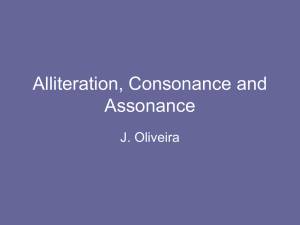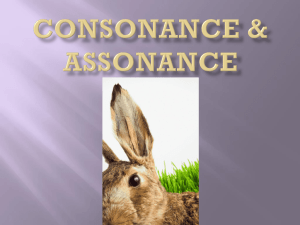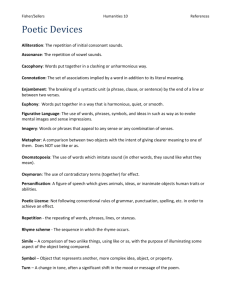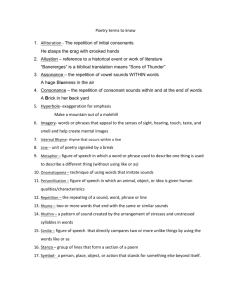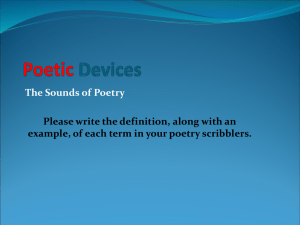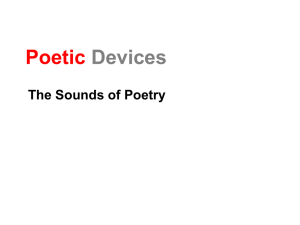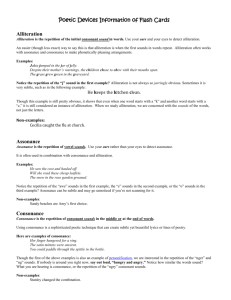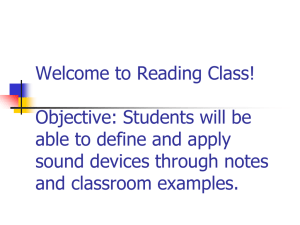sound?
advertisement
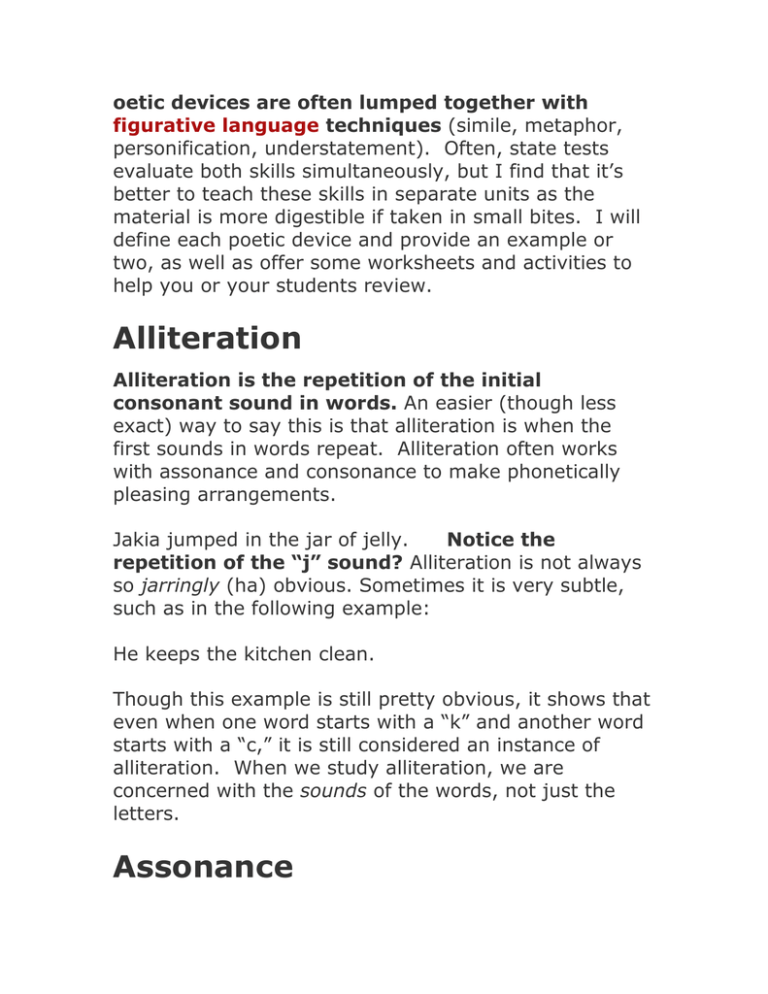
oetic devices are often lumped together with figurative language techniques (simile, metaphor, personification, understatement). Often, state tests evaluate both skills simultaneously, but I find that it’s better to teach these skills in separate units as the material is more digestible if taken in small bites. I will define each poetic device and provide an example or two, as well as offer some worksheets and activities to help you or your students review. Alliteration Alliteration is the repetition of the initial consonant sound in words. An easier (though less exact) way to say this is that alliteration is when the first sounds in words repeat. Alliteration often works with assonance and consonance to make phonetically pleasing arrangements. Jakia jumped in the jar of jelly. Notice the repetition of the “j” sound? Alliteration is not always so jarringly (ha) obvious. Sometimes it is very subtle, such as in the following example: He keeps the kitchen clean. Though this example is still pretty obvious, it shows that even when one word starts with a “k” and another word starts with a “c,” it is still considered an instance of alliteration. When we study alliteration, we are concerned with the sounds of the words, not just the letters. Assonance Assonance is the repetition of vowel sounds. It is often used in combination with consonance and alliteration. He saw the cost and hauled off. Notice the repetition of the “awe” sounds? (Depending on your dialect I suppose). Assonance can be subtle and may go unnoticed if you’re not scanning for it. Consonance Also known as near rhyme, off rhyme, or slant rhyme, consonance is the repetition of consonant sounds in the middle or at the end of words. Using consonance is a sophisticated poetic technique that can create subtle yet beautiful lyrics or lines of poetry. Here is an example of consonance: Her finger hungered for a ring. Though the above statement is also an example of personification, we are interested in the repetition of the “nger” and “ng” sounds. If nobody is around you right now, say out loud, “hungry and angry.” Notice how similar the words sound? What you are hearing is consonance, or the repetition of the “ngry” consonant sounds. Enjambment Enjambment is when the writer uses line breaks meaningfully and abruptly to create dual meanings or for emphasis. When a poem is read, the reader will conventionally make a slight pause (shorter than a comma) when transitioning from line to line in a poem. When a writer uses enjambment, he or she uses this space to spread an idea. Rolling through the field in the dead of winter. When the word “dead” is placed on a line in isolation, it invites the reader to focus on that idea. Surrounded by blank audio space, the idea may resonate powerfully. Though enjambment could be used during a speech, the term “enjambment” is generally exclusive to the study of poetry. Imagery Imagery is when the writer or speaker uses their descriptions to access the senses of the reader of listener. Sometimes this is called, using sensory details. When I say “senses” or “sensory,” I am referring to the five senses: sight, hearing, taste, touch, and smell. An old lump of snow melted in the corner. As you read this, you might be visualize it, because the description accesses your sense of sight. Repetition Repetition is when the writer or speaker knowingly repeats a word or group of words for effect. This is a strong rhetorical technique that can also be used to build a theme in a speech or poem. It is important to note that it is not considered using repetition when a writer or speaker repeats essential articles, prepositions, pronouns, or conjunctions that are frequently used unintentionally as the mechanics of language dictate. Nobody, oh nobody can make it out here alone. In the above example, only one word in the sentence is repeating: nobody. Nonetheless, this is still considered repetition. A poet, writer, or speaker may also repeat more than one word to have a greater impact or to highlight the importance of an idea, such as in the following example: Free at last. Free at last. Lord Almighty, we are free at last. In this example a whole group of words repeats: Free at last. Each method of repetition can effectively embolden a message. Rhyme Rhyme is when the end or final sound of two or more words are identical. If the end sounds are not identical, then the speaker or writer is using consonance or assonance instead. Rhymes can also occur internally or on the inside of words or lines of poetry. A rhyme may also be monosyllabic (a one syllable rhyme) or polysyllabic (rhyme two or more syllables), such as in the following example: I left my punch card on the lunch yard. This is the technique that students most often associate with poetry, but I encourage my students to try writing free or blank verse, as it takes much poetic skill to freely maneuver within the confines of a rhyme scheme. Rhythm Rhythm is when the arrangement of words creates an audible pattern or beat when read out loud. A good way to check to see if a passage of text is using rhythm is to just hum the sounds that the words make rather than clearly pronouncing them. If you can hear a song or identify a form in the sounds, then the text is rhythmic. There once was a guy from Chicago / Who drank away all of his problems Instead of reading the words, trying saying “Dun-dun-dun-dun-dun-dun-dun-dun-dun / Dundun-dun-dun-dun-dun-dun-dun-dun.” Do you hear how it sort of bounces? This is a rhythm.
